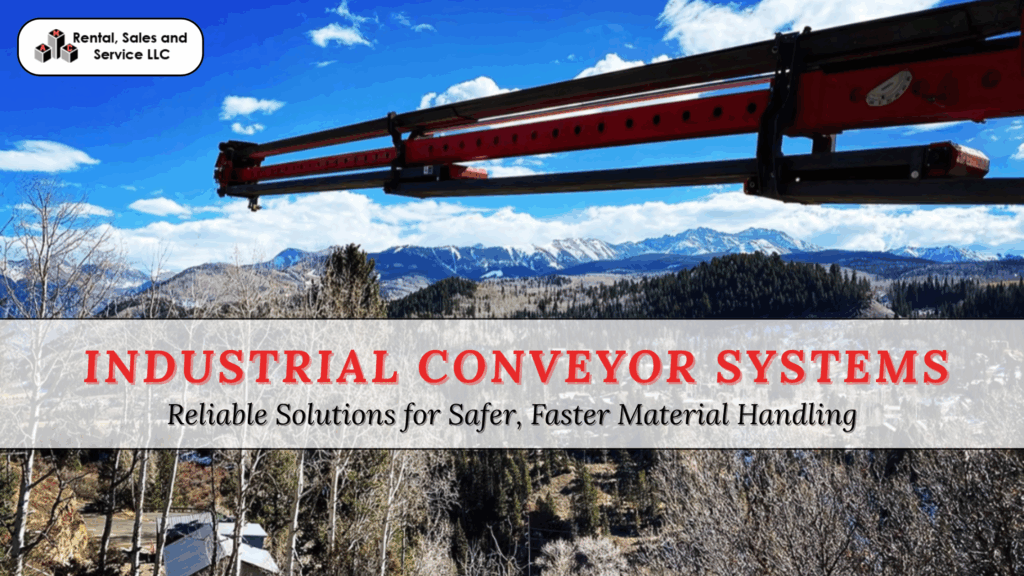All the time, the handling of bulky items in many projects can be extremely daunting. For construction, mining, or manufacturing, all these activities pose the same problem of having to be efficient, all while handling large equipment. It so happens that in these situations, you can make use of industrial conveyor systems. Industrial conveyor systems make the handling of bulky items easier, reduce the cost of labor, and increase the rate of production of the project under consideration.
From deciding what conveyors to use to conveyor belts for construction, it seems that many industries value the time these systems save. Buying conveyor belts that suit specific project requirements can be easily acquired.
What are Industrial Conveyor Systems?
As far as moving Industrial Materials goes, it would seem that these industrial conveyor systems make it very easy to do so. Based on what material and the purpose it serves, Industrial Conveyor belts and rollers can be used together to carry light to even extremely heavy loads, or even bulk and delicate items.
They can be used at construction sites to move heavy materials like concrete, at warehouses to sort and distribute items, and in the mining and food industries, along with packaging. For all Industrial uses, these systems are the simplest and most flexible solutions for all requirements. They are extremely reliable and efficient.
Why Conveyor Solutions Matter for Projects?
Choosing the proper conveyor solutions saves time and money by replacing tedious and dangerous manual lifting of loads with a more consistent and safer automated moving system. Many prefer these systems due to the efficiency in fast bulk material moves, reduced workplace accident and injury costs, labor costs, and ROI efficiency, and system scalability for any project. A conveyor belt for construction sites increases productivity by seamless transfer of heavy construction materials like cement, bricks, and gravel with minimal time loss.
Why Conveyor Belts for Construction are a Game-Changer?
Conveyor belts for construction are designed to have greater strength and greater durability over standard belts, as well as the ability to sustain heavy, rough, and uneven loads. In addition, they are able to sustain heat, dust, and moisture, as well as rough and abrasive materials like sand, stones, and concrete.
Their performance and lasting ability in durable projects reduce downtime and provide dependable support for daily construction. Many contractors using construction conveyor belt systems optimize their productivity by more than 40%, as workers can focus on their main skills while the belt seamlessly handles heavy material transport.
How Not to Overpay for Conveyor Belt Systems?
While buying conveyor belt systems, you should think about the following elements:
- Belt Capacity: What volume of weight will the belt carry?
- Construction Material: Pick belts designed specifically for the material (stone, sand, and chemicals).
- Life Span: For construction, belts that are blunt and harsh-resistant will always be the best option.
- Ease of Care: Prefer belts that are easy to maintain and repair.
- Price: Measure the cost against the value over time.
Equally prioritizing these elements against your project objectives will ensure that you get the best conveyor solutions for your site.
Benefits of Industrial Conveyor Systems
Adopting an Industrial conveyor system brings numerous advantages:
- Potential time saving: Material movement in a conveyor system can eliminate stagnant processes in a workflow.
- Dramatically lower the cost of indirect labor: Heavy lifting can be automated with the use of a conveyor.
- Improved precision: Minimal error rates for material handling and positioning.
- Lower energy consumption: Sustainable alternatives are available, and most of them tend to be cheaper.
Today, these systems are not just any additional feature; they are a requirement.
Frequent Mistakes Made When Selecting Conveyor Solutions
A poorly made choice concerning an economic conveyor system can diminish the overall value of the system to a business. Despite its benefits, the value can diminish as a result of the many mistakes made in regard to:
- Not calculating the load requirements before making a final decision on the belts.
- The absence of scheduled maintenance.
- Failing to consider the presence of damp and warm conditions.
- Purchasing cheap systems results in higher repair costs later.
Conclusion
To modern-day industries and large-scale projects, industrial conveyor systems are vital. Whether it’s selecting comprehensive conveyor solutions, purchasing a conveyor belt for construction, or buying a conveyor belt, informed decisions foster improved effectiveness, safety, and sustained savings. For advanced and reliable solutions tailored for your needs, visit AMC Conveyors.
FAQs
Q1. What industries make use of industrial conveyor systems the most?
Construction, as well as mining, along with the food industries, and logistics.
Q2. What is the difference between a belt used for construction and a normal belt?
Rough conditions, heavy, and slow-moving belts, which have the ability to withstand friction, abrasion, as well as resilient ability, are what construction belts are built for and serve well in.
Q3. Before purchasing conveyor belt systems, what do you consider?
The price differences, along with price differences, must take into consideration the belt systems’ effectiveness, maintenance demands, and overall factors.
Q4. Do conveyor systems contribute to global warming?
Many conveyor systems, especially the new types, are known for their ability to cut down operational costs. This, along with the greatly lowered impact on the environment, makes conveyor systems eco-friendly.

